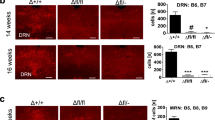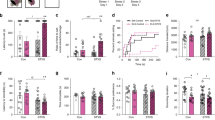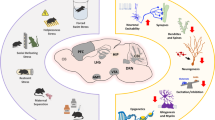Abstract
Traumatic stress in early life is a strong risk factor for psychiatric disorders that can affect individuals across several generations. Although the underlying mechanisms have been proposed to implicate serotonergic transmission in the brain, the neural circuits involved remain poorly delineated. Using pharmacological functional magnetic resonance imaging in mice, we demonstrate that traumatic stress in postnatal life alters 5-HT1A receptor-evoked local and global functions in both, the exposed animals and their progeny when adult. Disrupted functional connectivity is consistent across generations and match limbic circuits implicated in mood disorders, but also networks not previously linked to traumatic stress. These findings underscore the neurobiology and functional mapping of transgenerational effects of early life experiences.
This is a preview of subscription content, access via your institution
Access options
Subscribe to this journal
Receive 12 print issues and online access
$259.00 per year
only $21.58 per issue
Buy this article
- Purchase on Springer Link
- Instant access to full article PDF
Prices may be subject to local taxes which are calculated during checkout




Similar content being viewed by others
References
Ehlert U . Enduring psychobiological effects of childhood adversity. Psychoneuroendocrinology 2013; 38: 1850–1857.
Bowers ME, Yehuda R . Intergenerational transmission of stress in humans. Neuropsychopharmacology 2016; 41: 232–244.
Franklin TB, Saab BJ, Mansuy IM . Neural mechanisms of stress resilience and vulnerability. Neuron 2012; 75: 747–761.
Yehuda R, Daskalakis NP, Bierer LM, Bader HN, Klengel T, Holsboer F et al. Holocaust exposure induced intergenerational effects on FKBP5 methylation. Biol Psychiatry 2015; 80: 372–380.
Franklin TB, Linder N, Russig H, Thony B, Mansuy IM . Influence of early stress on social abilities and serotonergic functions across generations in mice. PLoS One 2011; 6: e21842.
Franklin TB, Russig H, Weiss IC, Graff J, Linder N, Michalon A et al. Epigenetic transmission of the impact of early stress across generations. Biol Psychiatry 2010; 68: 408–415.
Bohacek J, Farinelli M, Mirante O, Steiner G, Gapp K, Coiret G et al. Pathological brain plasticity and cognition in the offspring of males subjected to postnatal traumatic stress. Mol Psychiatry 2015; 20: 621–631.
Weiss IC, Franklin TB, Vizi S, Mansuy IM . Inheritable effect of unpredictable maternal separation on behavioral responses in mice. Front Behav Neurosci 2011; 5: 3.
Razoux F, Baltes C, Mueggler T, Seuwen A, Russig H, Mansuy I et al. Functional MRI to assess alterations of functional networks in response to pharmacological or genetic manipulations of the serotonergic system in mice. Neuroimage 2013; 74: 326–336.
Schwarz AJ, Gozzi A, Bifone A . Community structure in networks of functional connectivity: resolving functional organization in the rat brain with pharmacological MRI. Neuroimage 2009; 47: 302–311.
Schwarz AJ, Gozzi A, Reese T, Bifone A . In vivo mapping of functional connectivity in neurotransmitter systems using pharmacological MRI. Neuroimage 2007; 34: 1627–1636.
Mueggler T, Razoux F, Russig H, Buehler A, Franklin TB, Baltes C et al. Mapping of CBV changes in 5-HT(1A) terminal fields by functional MRI in the mouse brain. Eur Neuropsychopharmacol 2011; 21: 344–353.
Hannon J, Hoyer D . Molecular biology of 5-HT receptors. Behav Brain Res 2008; 195: 198–213.
Gozzi A, Jain A, Giovannelli A, Bertollini C, Crestan V, Schwarz AJ et al. A neural switch for active and passive fear. Neuron 2010; 67: 656–666.
Haber SN, Knutson B . The reward circuit: linking primate anatomy and human imaging. Neuropsychopharmacology 2010; 35: 4–26.
Advani T, Hensler JG, Koek W . Effect of early rearing conditions on alcohol drinking and 5-HT1A receptor function in C57BL/6 J mice. Int J Neuropsychopharmacol 2007; 10: 595–607.
Arborelius L, Hawks BW, Owens MJ, Plotsky PM, Nemeroff CB . Increased responsiveness of presumed 5-HT cells to citalopram in adult rats subjected to prolonged maternal separation relative to brief separation. Psychopharmacology (Berl) 2004; 176: 248–255.
Bravo JA, Dinan TG, Cryan JF . Early-life stress induces persistent alterations in 5-HT1 A receptor and serotonin transporter mRNA expression in the adult rat brain. Front Mol Neurosci 2014; 7: 24.
Gartside SE, Johnson DA, Leitch MM, Troakes C, Ingram CD . Early life adversity programs changes in central 5-HT neuronal function in adulthood. Eur J Neurosci 2003; 17: 2401–2408.
Lambas-Senas L, Mnie-Filali O, Certin V, Faure C, Lemoine L, Zimmer L et al. Functional correlates for 5-HT(1 A) receptors in maternally deprived rats displaying anxiety and depression-like behaviors. Prog Neuropsychopharmacol Biol Psychiatry 2009; 33: 262–268.
Law AJ, Pei Q, Feldon J, Pryce CR, Harrison PJ . Gene expression in the anterior cingulate cortex and amygdala of adolescent marmoset monkeys following parental separations in infancy. Int J Neuropsychopharmacol 2009; 12: 761–772.
Law AJ, Pei Q, Walker M, Gordon-Andrews H, Weickert CS, Feldon J et al. Early parental deprivation in the marmoset monkey produces long-term changes in hippocampal expression of genes involved in synaptic plasticity and implicated in mood disorder. Neuropsychopharmacology 2009; 34: 1381–1394.
Leventopoulos M, Russig H, Feldon J, Pryce CR, Opacka-Juffry J . Early deprivation leads to long-term reductions in motivation for reward and 5-HT1 A binding and both effects are reversed by fluoxetine. Neuropharmacology 2009; 56: 692–701.
Li M, Xue X, Shao S, Shao F, Wang W . Cognitive, emotional and neurochemical effects of repeated maternal separation in adolescent rats. Brain Res 2013; 1518: 82–90.
Maniam J, Morris MJ . Voluntary exercise and palatable high-fat diet both improve behavioural profile and stress responses in male rats exposed to early life stress: role of hippocampus. Psychoneuroendocrinology 2010; 35: 1553–1564.
Neumaier JF, Edwards E, Plotsky PM . 5-HT(1B) mrna regulation in two animal models of altered stress reactivity. Biol Psychiatry 2002; 51: 902–908.
Oreland S, Pickering C, Gokturk C, Oreland L, Arborelius L, Nylander I . Two repeated maternal separation procedures differentially affect brain 5-hydroxytryptamine transporter and receptors in young and adult male and female rats. Brain Res 2009; 1305 (Suppl):S37–49.
Shrestha SS, Nelson EE, Liow JS, Gladding R, Lyoo CH, Noble PL et al. Fluoxetine administered to juvenile monkeys: effects on the serotonin transporter and behavior. Am J Psychiatry 2014; 171: 323–331.
Shrestha SS, Pine DS, Luckenbaugh DA, Varnas K, Henter ID, Innis RB et al. Antidepressant effects on serotonin 1 A/1B receptors in the rat brain using a gene x environment model. Neurosci Lett 2014; 559: 163–168.
Spinelli S, Chefer S, Carson RE, Jagoda E, Lang L, Heilig M et al. Effects of early-life stress on serotonin(1 A) receptors in juvenile Rhesus monkeys measured by positron emission tomography. Biol Psychiatry 2010; 67: 1146–1153.
Vicentic A, Francis D, Moffett M, Lakatos A, Rogge G, Hubert GW et al. Maternal separation alters serotonergic transporter densities and serotonergic 1 A receptors in rat brain. Neuroscience 2006; 140: 355–365.
Burghy CA, Stodola DE, Ruttle PL, Molloy EK, Armstrong JM, Oler JA et al. Developmental pathways to amygdala-prefrontal function and internalizing symptoms in adolescence. Nat Neurosci 2012; 15: 1736–1741.
Savitz J, Lucki I, Drevets WC . 5-HT(1 A) receptor function in major depressive disorder. Prog Neurobiol 2009; 88: 17–31.
Shrestha S, Hirvonen J, Hines CS, Henter ID, Svenningsson P, Pike VW et al. Serotonin-1A receptors in major depression quantified using PET: controversies, confounds, and recommendations. Neuroimage 2012; 59: 3243–3251.
Hurley LM, Sullivan MR . From behavioral context to receptors: serotonergic modulatory pathways in the IC. Front Neural Circuits 2012; 6: 58.
Kaneko WM, Riley EP, Ehlers CL . Effects of artificial rearing on electrophysiology and behavior in adult rats. Depress Anxiety 1996; 4: 279–288.
Lesch KP, Waider J . Serotonin in the modulation of neural plasticity and networks: implications for neurodevelopmental disorders. Neuron 2012; 76: 175–191.
Linnman C, Moulton EA, Barmettler G, Becerra L, Borsook D . Neuroimaging of the periaqueductal gray: state of the field. Neuroimage 2012; 60: 505–522.
Bullmore E, Sporns O . Complex brain networks: graph theoretical analysis of structural and functional systems. Nat Rev Neurosci 2009; 10: 186–198.
Jovanovic H, Perski A, Berglund H, Savic I . Chronic stress is linked to 5-HT(1A) receptor changes and functional disintegration of the limbic networks. Neuroimage 2011; 55: 1178–1188.
Cisler JM, James GA, Tripathi S, Mletzko T, Heim C, Hu XP et al. Differential functional connectivity within an emotion regulation neural network among individuals resilient and susceptible to the depressogenic effects of early life stress. Psychol Med 2013; 43: 507–518.
Gapp K, Jawaid A, Sarkies P, Bohacek J, Pelczar P, Prados J et al. Implication of sperm RNAs in transgenerational inheritance of the effects of early trauma in mice. Nat Neurosci 2014; 17: 667–669.
Gapp K, Soldado-Magraner S, Alvarez-Sanchez M, Bohacek J, Vernaz G, Shu H et al. Early life stress in fathers improves behavioural flexibility in their offspring. Nat Commun 2014; 5: 5466.
Elton A, Tripathi SP, Mletzko T, Young J, Cisler JM, James GA et al. Childhood maltreatment is associated with a sex-dependent functional reorganization of a brain inhibitory control network. Hum Brain Mapp 2013; 35: 1654–1667.
Gould GG, Hensler JG, Burke TF, Benno RH, Onaivi ES, Daws LC . Density and function of central serotonin (5-HT) transporters, 5-HT1A and 5-HT2A receptors, and effects of their targeting on BTBR T+tf/J mouse social behavior. J Neurochem 2011; 116: 291–303.
Hahn A, Stein P, Windischberger C, Weissenbacher A, Spindelegger C, Moser E et al. Reduced resting-state functional connectivity between amygdala and orbitofrontal cortex in social anxiety disorder. Neuroimage 2011; 56: 881–889.
Stevenson RA . Using functional connectivity analyses to investigate the bases of autism spectrum disorders and other clinical populations. J Neurosci 2012; 32: 17933–17934.
Finn ES, Shen X, Scheinost D, Rosenberg MD, Huang J, Chun MM et al. Functional connectome fingerprinting: identifying individuals using patterns of brain connectivity. Nat Neurosci 2015; 18: 1664–1671.
Acknowledgements
This study was supported by the University of Zurich, the Swiss Federal Institute of Technology, the Swiss National Science Foundation, the National Center of Competence in Research 'Neural Plasticity and Repair' and Roche. We thank Ry Tweedie-Cullen and Lukas von Ziegler for help with statistics.
Author information
Authors and Affiliations
Corresponding author
Ethics declarations
Competing interests
The authors declare no conflict of interest.
Additional information
Supplementary Information accompanies the paper on the Molecular Psychiatry website
Rights and permissions
About this article
Cite this article
Razoux, F., Russig, H., Mueggler, T. et al. Transgenerational disruption of functional 5-HT1AR-induced connectivity in the adult mouse brain by traumatic stress in early life. Mol Psychiatry 22, 519–526 (2017). https://doi.org/10.1038/mp.2016.146
Received:
Revised:
Accepted:
Published:
Issue Date:
DOI: https://doi.org/10.1038/mp.2016.146
This article is cited by
-
Uncovering Statistical Links Between Gene Expression and Structural Connectivity Patterns in the Mouse Brain
Neuroinformatics (2021)
-
Exploring the impact of trauma type and extent of exposure on posttraumatic alterations in 5-HT1A expression
Translational Psychiatry (2020)
-
The future of rodent models in depression research
Nature Reviews Neuroscience (2019)



